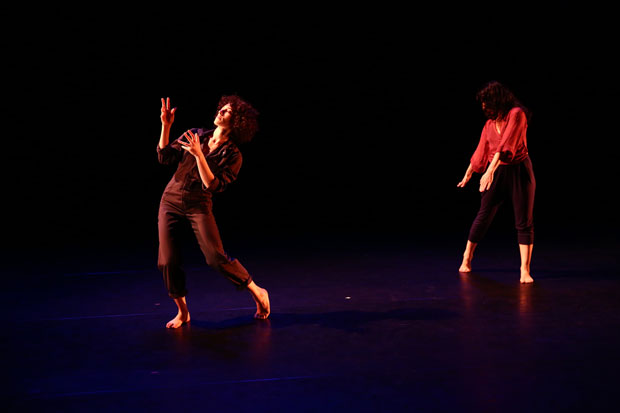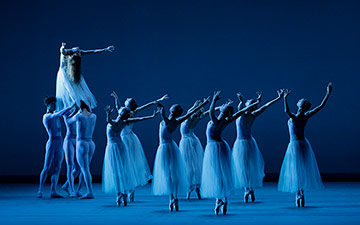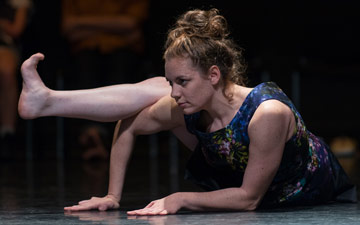
© Paula Court. (Click image for larger version)
Vicky Shick
Lumberyard in the City festival: Let it Linger
★★★✰✰
New York, The Kitchen
8 June 2017
www.thelumberyard.org/nyc/vicky-shick/
thekitchen.org
Film Stills
Vicky Shick’s dances are a little bit like silent family movies, a series of scenes from a life, edited together in no apparent order. There are funny bits and sad bits and quiet bits, and even the odd intimate moment. You can sort of guess at what’s being said or left unsaid, or what’s going on just beyond the frame. It’s a world of women – perhaps its inhabitants are sisters or friends or lovers or neighbors or, who knows?
Let it Linger, Shick’s new work, performed at The Kitchen as part of the LUMBERYARD Contemporary Performing Arts series, has all these elements, plus a new one: a video design of trees and scrubland by Seline Baumgartner, a Swiss video artist. There is also a little promontory at the back of the stage, made up of rolls of grass, the kind people lay out on their lawns. Like the little table that makes an appearance, these are elements of life: nature, the kitchen, the trees. The designs are by Baumgartner as well.

© Paula Court. (Click image for larger version)
Most of the work is performed in silence, but every so often a bit of music will waft on, like a memory or a car radio. A bit of jazz or accordion music, never jarring, but not particularly significant either. It does help to alleviate the silence. More integral are the changes in lighting, by Carol Mullins, which suggest different moods. Also the costume changes, which accentuate the sense that what is being depicted is a series of moments in time. Periodically, the activity stops and the audience sees before it a little tableau, like a film still containing two or three or four women, sitting or standing together, looking out, each with her own expression: desolate or wry or direct.
The four women have strong personalities, as does Shick herself, who opens the dance with a solo full of loopy moves: undulating hips and supple arm swings and bends from the waist and relaxed nods of the head. (For six years, she danced for Trisha Brown, and it shows.) Her movement has a wonderful sense of texture and character; it never looks plain. Toward the end of her solo, she begins to punch the air, and then backs offstage, never to return. Material from that solo pops up throughout the hour-long dance. The evening is carefully structured, minutely paced; one can see the craft and care that has gone into its creation. Nothing is out of place.

© Paula Court. (Click image for larger version)
One never really tires of watching these women as they run and lope and flick their wrists or link arms and carry out their private dramas. Two of them (Anna Azrieli and Marilyn Maywald-Yahel) sit at a table and eat a salad. Then, suddenly, Azrieli blurts out “I love you”; a moment later, she angrily punches Maywald-Yahel’s arm. That counts as high drama. In a moment of tenderness, Lily Gold and Azrieli hold each other, after which they adjust their clothes as if preparing to go for a run. Later, Mina Nishimura, looking vulnerable, repeats “I’m sorry” into a microphone a few times, only to break into a funny, awkward run, clownish but also somehow exposed and alone.
As you can see, the world of Let it Linger is a world of small things. You may wonder, is it enough? And it’s a fair question. The work’s aspirations are modest. Perhaps too modest. One can’t help but feel that Shick could do more, push herself and her dancers into more rigorous territory, risk more. Despite its title, it is a dance that does not crawl under one’s skin or linger for long in the mind.

















You must be logged in to post a comment.